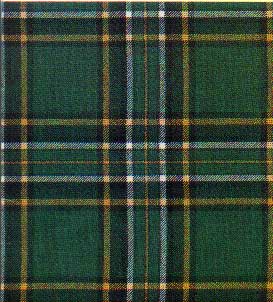















A kilt is a garment like no other, a truly unique addition to a man's wardrobe. Bryant Johnson boasts to his potential clients: "If you are shy, do not buy a kilt." Who do you think stands out in a room filled with men in tuxedos?
Kilt making is truly a specialized tradition that may even be considered an art form. This is a garment that will outlast the purchaser as well as his son and grandson if it is of a finer quality. It may even be considered an investment. Real kilts are not mass produced. They are hand made garments made to order. One of the difficulties of kilt making is replicating the tartan pattern in the pleats (ask someone who has tried to make one on their own). They call this "pleating to the sett" and takes years to master.
Our kilts are handmade by master tailors. We import our material from the finest mills in Scotland. Although kilts can be made using an 8oz feather weight cloth or even a 18oz regimental weight, our kilts are a medium (13oz) or a heavy weight (16oz) worsted wool. Kilts made in these heavier qualities do not require as much maintenance.
The money initially saved buying a lighter weight material will quickly add up at the dry cleaners. Most cleaners charge by the pleat for pressing, easily costing $30. a visit. Our kilts do not require pressing when cleaned. The more material used to make a kilt the deeper the pleats will be. Although kilts can be made from a minimum of 7 yards of material, we use a minimum of 9 yards. The deeper the pleats the better the garment will hang and swing at the back. Our medium weight, nine yard kilts cost $950. Canadian.
Please contact us by E-mail, telephone or fax. We will be pleased to let you know which tartans are available and how long it will take to make the kilt (delivery is approximately ten weeks: longer in the summer as many mills close in Scotland for the summer holidays.).
| Yes, it's true! Irish tartans are now being produced! These new tartans, inspired by Irish counties (not family names), are reminiscent of the country with soft warm colors dominating. When in doubt all may wear the Irish National tartan. |  |
Family name, Scottish district, or Canadian provinces classify Scottish tartans. Further they divide the family tartans into dress, hunting, modern and ancient colors. Generally, owning four kilts is not economically feasible, therefore people base their choice primarily on availability and color.
Dress tartans were originally used for formal occasions. Many of these tartans are predominantly white.
Hunting tartans are predominantly green and brown. They were worn hunting since these colors camouflaged the men.
The modern colors are based on coloring using today's technology. They are more vibrant.
The ancient tartans are replicas of the original dye lots used from vegetables.
Find out about the tartan ties and scarves available at Chas. Johnson & Fils.
| Tartan Ties | |
| Tartan Scarves |
Bare legs were the common form of dress in the Highlands starting from approximately 1100 A.D. In the 1500's, the standard outer garment worn by men was a "leine-chroich." This was a sort of shirt made from eight to nine meters of linen with tails falling below the knee.
The "feileadh mor," a wrap, eventually evolved from that garment and was commonly worn in the 17th and 18th centuries. This large blanket of woven cloth became known as a plaid. A man would wrap it around himself at knee level and fasten it with a belt. The upper half would hang around his torso and/or head depending on the weather. The moorland bogs and the Highlands were wet and damp therefore an outfit like this was detrimental to the mens' health. They striped the plaid material and used the colors purple and blue, though dark brown was preferable when hiding in heather on the moors. The material (wool) was water repellant and the weave was midge-proof (a type of insect). The plaid served as a sleeping bag at night. These garments were to be worn no longer than the top of the knee. Knees being very tender at the back would chafe easily when the kilt was wet.
The evolution of the plaid to the modern kilt may be traced back to Thomas Rawlins who was a Quaker ironmaster. Rawlins established an iron foundry near Inverness in 1727 that the men of the clan MacDonnell worked. They owned the territory in which the foundry was located. The plaid as it was worn then was not suitable for physical labour. A regimental tailor from Inverness named Parkinson was hired to make this traditional dress more suitable for manual labor. Parkinson simplified the plaid by separating the bottom half and sewing pleats so they remained in place: thus the modern kilt was born. This style caught on and by 1745 it was considered an essential part of a man's wardrobe.